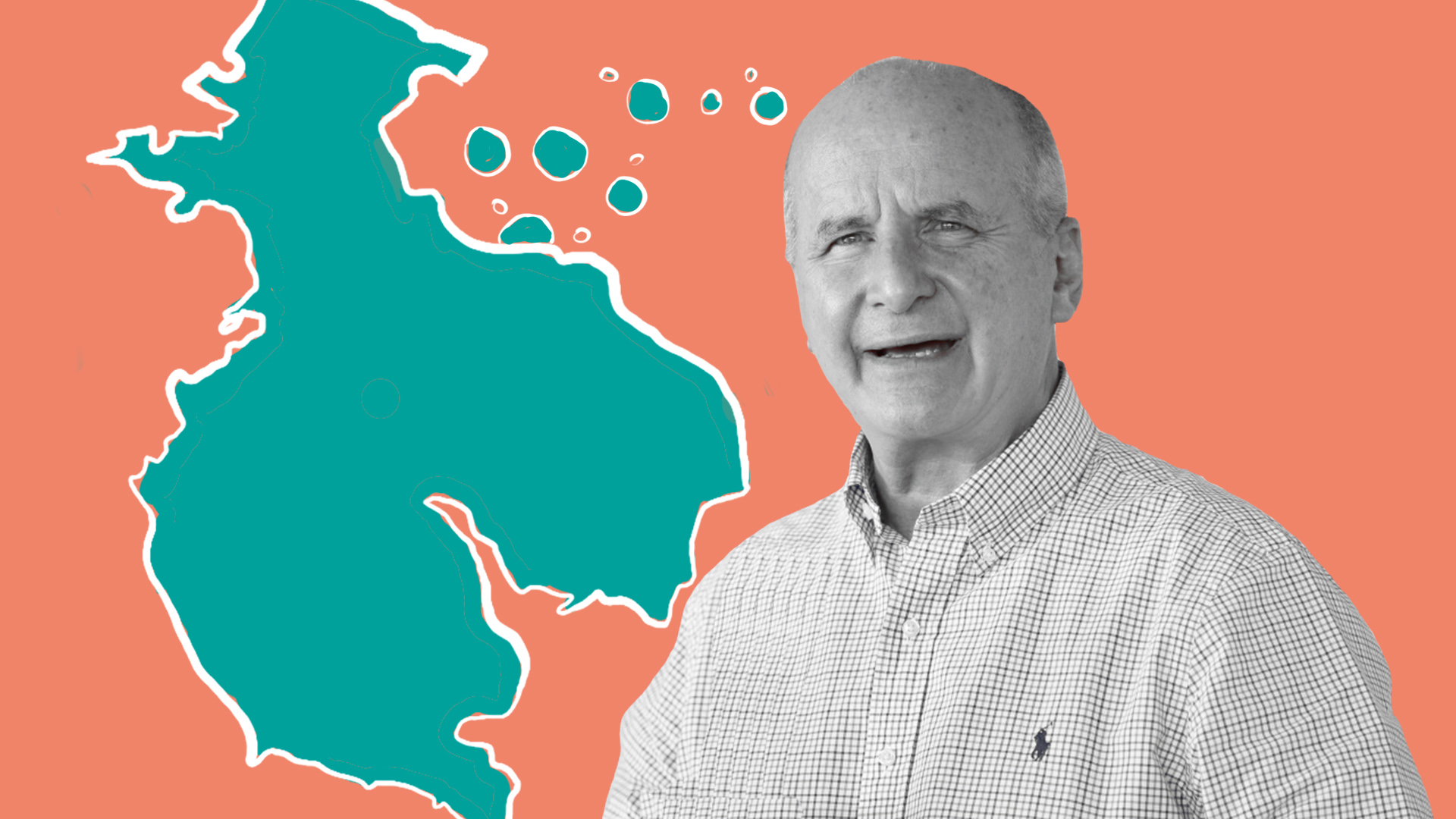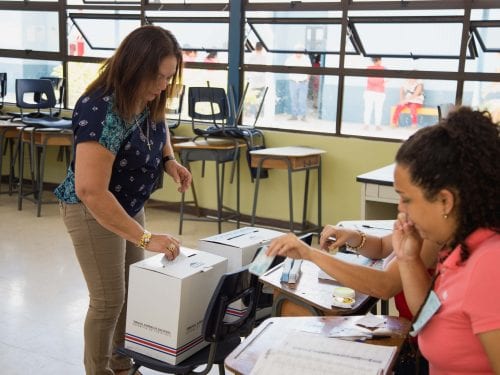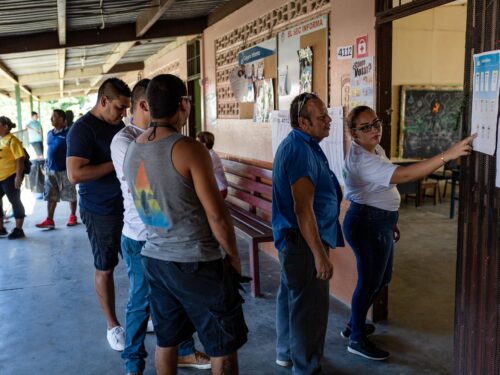
Of all the provinces, Guanacaste was the one that supported Jose Maria Figueres the most in the National Liberation Party’s last caucus elections. After being elected, the liberationist candidate has remained in the lead in voter polls done by the Center for Research in Political Studies (CIEP-UCR for the Spanish acronym).
Figueres was president of Costa Rica between 1994 and 1998. During his administration, the National Women’s Institute (INAMU- Instituto Nacional de las Mujeres) was created and Intel set up operations in Costa Rica. The liberationist also had the leading role in closing the Costa Rican Railway Institute (INCOFER- Instituto Costarricense de Ferrocarriles) and the Anglo Bank.
Now he’s attempting to preside over the country once again.
In the province, he is accompanied by well-known provincial political figures, with legislative candidates who have already held elected positions, including Luis Fernando Mendoza who served as legislator and as mayor of Cañas for two terms, Alejandra Larios as a municipal council member and a candidate for mayor of Liberia, and Carlos Cantillo as mayor for four terms in Carrillo.
Figueres promises that under his administration, Guanacaste would attract international companies that will provide jobs that don’t require specialized technological skills. He also proposes promoting medical tourism in the province and taking advantage of the image of the world’s blue zone to attract these tourists.
How does he intend to achieve that? We interviewed him via Zoom after he canceled his tour of the province when his wife tested positive for COVID-19. This transcript has been edited for better readability.
As president, what would you attend to with the most urgency in Guanacaste?
In the field of infrastructure, I see three things as a priority. First, speed up the construction of Cañas-Barranca. The second thing is that the renegotiation of the Daniel Oduber airport concession is about to begin and I’d look for a way to include runway maintenance in the concession, which isn’t included now, and resurfacing the runway is going to cost $100,000,000. And the third thing I want to mention is, of course, the water situation. The Paacume project is intended to solve that in an important way. And with that, the way in which Aqueducts and Sewers (AyA) solves it needs to be closely reviewed, especially in the province of Guanacaste, because I fear that it’s not up to the expectations that we Costa Ricans have.
Now then, Guanacaste is the cradle of all of our renewable energies and has enormous potential to continue investing in them and converting to green hydrogen, to replace the gasoline and diesel that we import and also for ammonia to be able to export it. Second, the agricultural sector today depicts the opportunity to make it resilient to climate change. Thirdly, I mention an advance in tourism towards health and wellness tourism that helps in what the world is looking for today, which are experiences, health, well being, exporting medical services and counting on Guanacaste as the blue zone, there’s a great comparative advantage. And as the fourth element, I’d mention everything that has to do with taking advantage of the new global trend called nearshoring, in other words bringing back companies with production processes that are in Asia, that want to produce closer to the North American markets, for which Costa Rica represents a huge opportunity.
How do you think that medical tourism can create more jobs for the people of Guanacaste?
Costa Rica has 500 million people living south of the border with Panama and another 500 million people north of the border with Nicaragua and we are geographically located in the center of the continent. We have an excellent reputation for providing health services. That makes us the ideal place for the export capital of health services to the rest of the continent.
I envision a large public-private alliance at the national level, but especially with facilities and investment in Guanacaste, taking advantage of Daniel Oduber [airport] and the hotel capacity that Guanacaste has to attract people who come to undergo surgery. And that would create thousands of highly qualified, well-paid job opportunities in everything that has to do with medical sciences, health and wellness, and its administration. A country that has 2,000 doctors without work, well, this is an excellent opportunity, but it’s also a unique opportunity.
Guanacaste has carried and cultivated that commitment to tourism for many years, which sometimes works very well, but we’ve also seen that in situations such as the pandemic, it has paralyzed the province’s economy. So what other proposals do you have to invigorate the economy and provide jobs for Guanacastecans?
Well, I’ll return to the concept of nearshoring. There’s an opportunity for Costa Rica, which on the one hand, has important free trade zones and a very robust free trade zone regime, and on the other hand, Free Trade Agreements that connect us with half of the planet’s consumers, to be the country that attracts more of those companies.
Many of the companies that can be attracted today are manufacturing processes, which are going to create job opportunities that don’t require as much technological studies, but that Costa Rica can perfectly advance with them in a very competitive way for companies and creating opportunities of well-paid work in our country. And along with that, I want to mention that the province of Guanacaste is precisely where the national energy transition should start in our country. It’s the opportunity for us to start producing much more renewable energy to convert it into green hydrogen that replaces gasoline and diesel. And this energy revolution creates thousands of job opportunities that range from installing wind farms, solar parks, going through the installation and management of production processes that convert that energy into green hydrogen.
We’ve seen that it’s a challenge for Guanacastecans to get into specialized careers, which pretty much aren’t taught in the province, such as medicine. On the other hand, a recurring bet is to attract companies that require people with basic studies. But then how do we find the balance to combat the province being behind in education?
I see three very important things. First, reinforce literacy in boys and girls with a large national crusade where we appeal to teachers, retired people and other people to come help us in this task. Second, we have a responsibility with 250 to 300,000 young people who either didn’t finish high school, or finished it and are unemployed or are just beginning to go to universities, to whom we have the responsibility to offer short courses for soft skills that allow employability of these young people in a new economic engine. And we want to do this with a scholarship program for these young people, paying them while they study their short courses of six or eight months that allow them to then work even beyond our borders. And third, a vigorous, permanent program at the same time with teachers in this country to remove administrative burdens that are crazy today, so that they can spend more time in the classroom, and on the other hand, help them in their permanent training, not only with respect to the subjects, but also with respect to this hybrid educational model that we are heading towards, which is part in-person and part virtual.
And with regard to what you said about the airport concession, what’s your position regarding the current one?
As with so many things in life, it seems to me that there is room here for better coordination between the concession-holder and the government to provide the necessary services between both of them, so that the tourist receives the best impression. At this moment, the people that I’ve assigned to study the concessions in the country have reported to me that an investment of some $100 million would be required to resurface the runway and it will be an investment that the government should make, but in the future, with the traffic at the airport now, it seems logical to me to include runway maintenance within the concession.
Returning to the province’s most relevant industries, how do you plan to provide fishermen and women with supplies and training to diversify their industry?
I think that this should move forward in a direction where we take advantage of the resources that our sea gives us and that have better added value in international markets, which are always much broader and much larger than the Costa Rican market. The Costa Rican Fishing and Aquaculture Institute (INCOPESCA- Instituto Costarricense de Pesca y Acuicultura) should be hand in hand with the fishermen in this structural transformation of their fishing skills. We also have the opportunity of marine farming with thousands of hectares that we have that were previously salt mines where we can now produce shrimp for the national market and for export. Now, in all of this, it seems to me that the fishermen’s association activities are important and that’s why the fishing cooperatives seem to me to play a fundamental role in being able to help organize this transition.
Regarding climate change, what programs would you launch to make communities resilient?
Regarding climate change. 1. Let’s lower carbon emissions. I’ve already mentioned the energy transition to progress in that direction. 2. When we’re going to make infrastructure, which ranges from houses to roads, going through buildings and all the other forms, let’s make infrastructure that takes advantage of materials that emit less carbon into the atmosphere and let’s design them in a way that takes advantage of air currents, that circulate water and many other conditions that are known today that allow us to progress towards a way of life that is much more respectful of the environment and much more intense in the use of its resources.
Finally, what actions or laws would you promote to reduce the numbers of femicides and gender violence?
In the future, we’re going to reinforce everything that has to do with the performance of the National Women’s Institute so that as an institution, it’s much stronger. We’re going to modernize the legislative framework to protect women and we’ll also hold special courses in the police forces to raise awareness of the aggression that women are subjected to in our country and where they need to contribute in an important way so that this stops being this way.







Comments